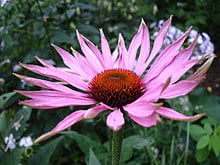Echinacea

Echinacea /ˌɛkɪˈneɪʃiə/[1] is a genus of herbaceous flowering plants in the daisy family. It has ten species, which are commonly called coneflowers. They are found only in eastern and central North America, where they grow in moist to dry prairies and open wooded areas. They have large, showy heads of composite flowers, blooming in summer. The generic name is derived from the Greek word ἐχῖνος (ekhinos), meaning “sea urchin”, due to the spiny central disk. These flowering plants and their parts have different uses. Some species are cultivated in gardens for their showy flowers. Echinacea purpurea is used in traditional medicine.[2] Two of the species, E. tennesseensis and E. laevigata, are listed in the United States as endangered species.[3]
Echinacea species are herbaceous, drought-tolerant perennial plants growing up to 140 cm or 4 feet,[4] in height. They grow from taproots, except E. purpurea, which grows from a short caudex with fibrous roots. They have erect stems that in most species are unbranched. Both the basal and cauline (stem) leaves are arranged alternately. The leaves are normally hairy with a rough texture, having uniseriate trichomes (1–4 rings of cells) but sometimes they lack hairs. The basal leaves and the lower stem leaves have petioles, and as the leaves progress up the stem the petioles often decrease in length. The leaf blades in different species may have one, three or five nerves. Some species have linear to lanceolate leaves, and others have elliptic- to ovate-shaped leaves; often the leaves decrease in size as they progress up the stems. Leaf bases gradually increase in width away from the petioles or the bases are rounded to heart shaped. Most species have leaf margins that are entire, but sometimes they are dentate or serrate.
